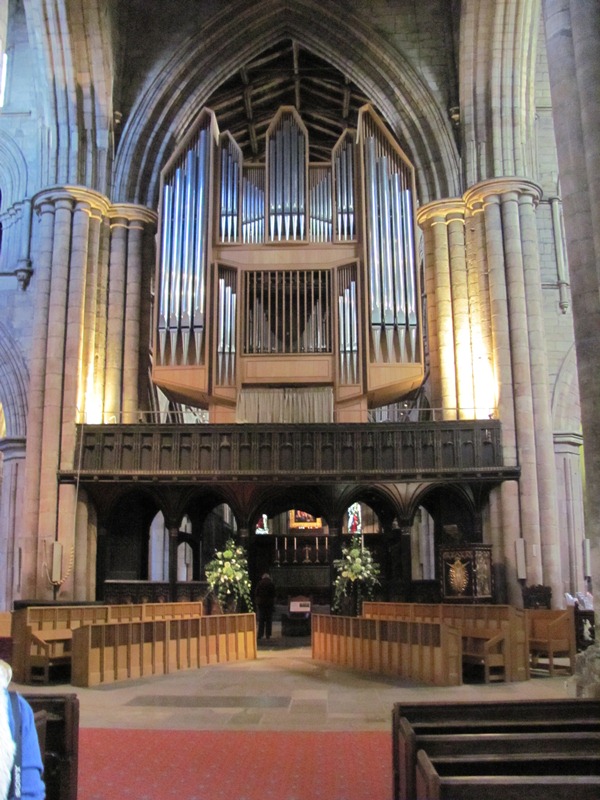Here against a lovely blue sky is Hexham Abbey. You can see the entrance off to the left of the picture. Had we spotted it straight away, we would have gone in but we went the other way. So here to start are a few pictures of our circumnavigation of the church.
Light shining right through the nave illuminated this window so it could be seen from the outside.
It would appear that somebody had a few security issues about this window.
This picture and the next show an area open to the pavement. To me it has the appearance of having been cloisters. While having a surf to find information about the abbey, I read that at the foot of the stairs (featured in two pictures time) there was a door leading into the cloisters, which has now been bricked up - it would have been in just the right place to open into this area.
Just inside the entrance we saw these stairs in the South transept. They're exceptionally old and were built for the canons use in the early 13th century. There is apparently lead on the steps which had dripped down from the roof when a Scottish army burned the priory in 1298.
This is a first century memorial to a Roman standard bearer. A Latin inscription just below this can be translated and, "To the Venerated departed: Here lies Flavius, a horse soldier of the cavalry regiment of Petriana. Standard bearer of the troop of Candidus, aged 25, of 7 years service." The regiment took it's name from it's commander, a Roman noble called Titus Pomponius Petra and Candidus would have been Flavius' decurian (who would have commanded about 16 men).
The nave is dominated by the Great West Window made by the Jersey born stained glass artist Henry Thomas Bosdet.
Besides this window, there are 3 other windows in the abbey by him, including the East window behind the altar. This one features Northumbrian saints and their histories.
The central character in the window is Queen Etheldreda who lived from 636 to 639 AD who was involved in a right royal hoohaa back in the day. Veteran of two unconsummated marriages she eventually joined a convent in around 670AD. Her husband, King Ecgthrith of Northumbria, rather disgruntled about the whole affair, eventually fell out with Wilfrid, bishop of York, over the whole matter. Etheldreda gave a grant of land to Wilfred which enabled him to build the abbey here, which is why in this window Etheldreda, she is seen holding the abbey. St. Wilfrid stands directly to St. Etheldreda's right in this window.
St. Etheldreda is sometimes known as St. Aethelthryth and by the more familiar St Audrey or Awdrey. The town of Ely had an annual fair in her name once where lace could be bought. When the lace fell out of fashion, and was viewed as cheap and poor quality it was described as St. Awdrey. This was eventually contracted and gives us the modern word tawdry. Not that there's anything tawdry about the lady in this window.
Here we have the saint that appears time and again in these pages. It's Saint Cuthbert of course and he's holding the head of St. Oswald.
St Oswald appears in his own panel in the window. Mr Bosdet has been careful to matched the appearance of the live St Oswald to his head in St Cuthbert's arms, even the design of the crown is the same.
Just inside the nave hangs the Millennium Banner and was made by the Hexham branch of the Embroiderers guild. The pictures in the circles at the side are all related to Hexham and the surrounding countryside.
This building stands opposite the abbey in the middle of the town. It is Hexham Gaol, reputedly the oldest purpose built prison in England, dating from 1330 - 1333.
Hexham has a racecourse.
This window, which we saw earlier in the blog from the outside, is by Stanley Murray Scott and celebrates the 50th anniversary of the Royal British Legion in 1971.
Close by is another window by Mr Murray, this one made in 1965 celebrates the Royal Flying Corp and the Royal Air Force.
The screen separating the nave from the choir and alter was made between 1419 and 1524 on the orders of the prior of the day, Thomas Smythson. It has been suggested that a large crucifixion scene may have occupied the area above it originally and that guilded statues would have occupied the alcoves you can see along the top. All are gone now and we'll just have to content ourselves with the paintings of saints along the bottom panels.
Much newer, the 1911 pulpit was designed by Temple Moore in the style of the old Flemish masters.
Above the sits the organ. Four organs have occupied this slot since 1819, this one since 1974.
More shortly from Hexham Abbey




































































.JPG)





